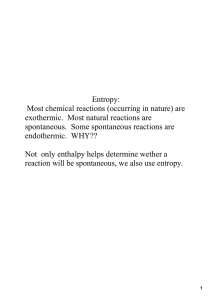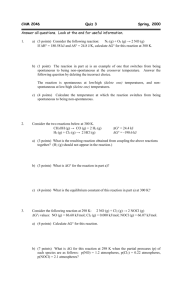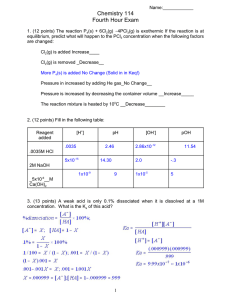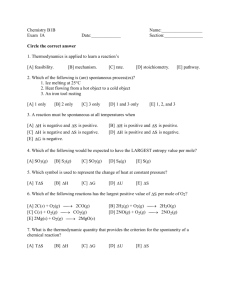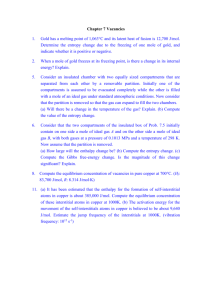2011 exam 3
advertisement
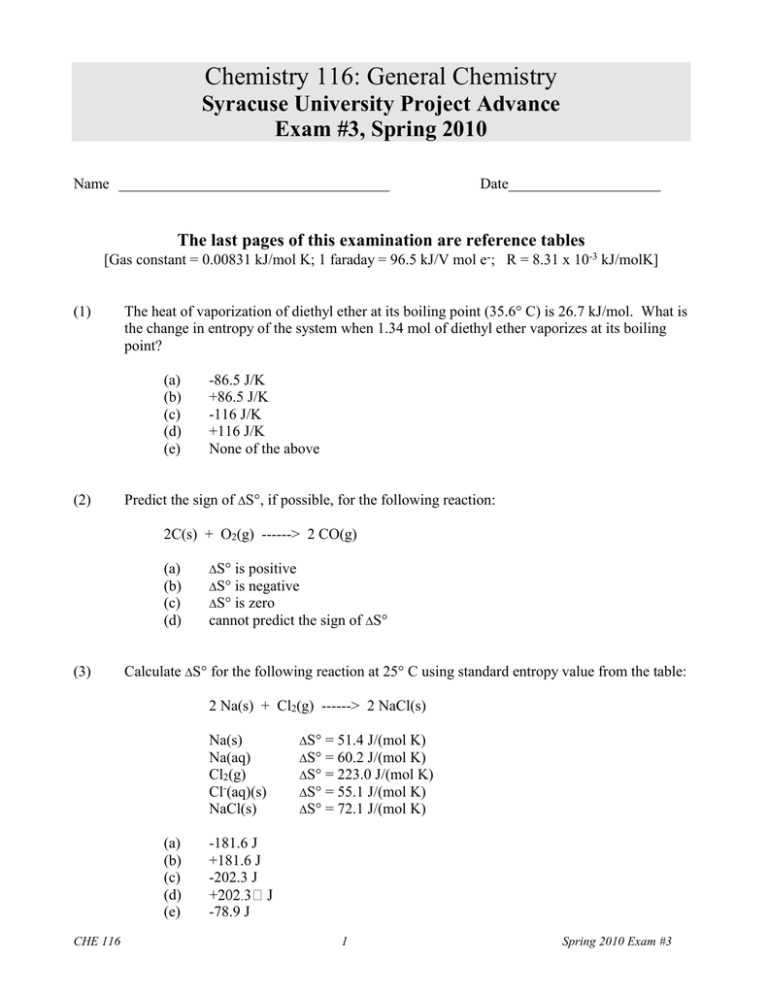
Chemistry 116: General Chemistry Syracuse University Project Advance Exam #3, Spring 2010 Name Date The last pages of this examination are reference tables [Gas constant = 0.00831 kJ/mol K; 1 faraday = 96.5 kJ/V mol e-; R = 8.31 x 10-3 kJ/molK] (1) The heat of vaporization of diethyl ether at its boiling point (35.6° C) is 26.7 kJ/mol. What is the change in entropy of the system when 1.34 mol of diethyl ether vaporizes at its boiling point? (a) (b) (c) (d) (e) (2) -86.5 J/K +86.5 J/K -116 J/K +116 J/K None of the above Predict the sign of S°, if possible, for the following reaction: 2C(s) + O2(g) ------> 2 CO(g) (a) (b) (c) (d) (3) S° S° S° is positive is negative is zero cannot predict the sign of S° Calculate S° for the following reaction at 25° C using standard entropy value from the table: 2 Na(s) + Cl2(g) ------> 2 NaCl(s) Na(s) Na(aq) Cl2(g) Cl-(aq)(s) NaCl(s) (a) (b) (c) (d) (e) CHE 116 S° S° S° S° S° = 51.4 J/(mol K) = 60.2 J/(mol K) = 223.0 J/(mol K) = 55.1 J/(mol K) = 72.1 J/(mol K) -181.6 J +181.6 J -202.3 J -78.9 J 1 Spring 2010 Exam #3 (4) For a reaction with H° > 0 and S° > 0, you can deduce that the reaction will be: (a) (b) (c) (d) (e) (5) For a mixture if He(g) in Ar(g), the standard entropy of mixing (S°) is: (a) (b) (c) (d) (6) spontaneous at all temperatures. nonspontaneous at all temperatures. spontaneous at low temperature; nonspontaneous at high temperature. nonspontaneous at low temperature; spontaneous at high temperature. none of the above. positive negative sometimes positive and sometimes negative cannot tell from the information provided. In a spontaneous process, a certain system, held at the constant temperature 300 K, absorbs 30 J of heat energy. From your knowledge of the various statements of the second Law of Thermodynamics, which of the following is the most accurate statement you can make about Ssystem for this spontaneous process? (a) Ssystem < -0.1 J/K (b) Ssystem > 0.1 J/K (c) Ssystem < -10 J/K (d) Ssystem0 J/K (e) none of these (7) Calculate G° for the following reaction at 500K. Cu(s) + H2O(g) ------> CuO(s) + H2(g) Cu(s) H2O(g) CuO(s) H2(g) (a) (b) (c) (d) (e) CHE 116 H°f (kJ/mol) S° (J/K) 0 -241.8 -155.2 0 33.3 188.7 43.5 130.6 +110.6 kJ -86.6 kJ +23.9 kJ -62.6 kJ +301 kJ 2 Spring 2010 Exam #3 For a certain hypothetical reaction at 27oC, Ho = 100 kJ/mole, and So = 500 J/mole. Calculate the GO for this reaction. (8) (a) –13400 kJ/mole (b) 86.5 kJ/mole (c) –149900 kJ/mole (d) 250 kJ/mole (e) –50 kJ/mole (9) For the reaction: 3 C(s) + 4 H2(g) <======> C3H8(g) S° = -29 J/(mol K) H° = -103.8 kJ/mol Calculate the equilibrium constant at 25° C for the reaction above. (a) (b) (c) (d) (e) (10) What is the minimum temperature required for the spontaneous conversion of CCl4(g) when H° is 573 kJ/mol and S° is 1640 J/(mol K) (a) (b) (c) (d) (e) (11) 1.04 0.962 2.09 x 10-17 4.79 x 1016 2.1 x 1032 76° C 89° C 189° C 215° C 349° C Which process below leads to a decrease in the entropy of the system as the process proceeds? I. II. III. IV. V. 2H2O (s) 2H2O (l) CaO (s) + CO2 (g) CaCO3 (s) 2C (s) + O2 (g) 2CO (g) 2MnO2 (s) 2MnO (s) + O2 (g) O (g) + O2 (g) O3 (g) (a) Only II leads to a decrease in entropy of the system (b) Only I leads to a decrease in entropy of the system (c) Both I and III leads to a decrease in the entropy of the system (d) Both II and V lead to a decrease in the entropy of the system (e) None of the processes lead to a decrease in the entropy of the respective systems. CHE 116 3 Spring 2010 Exam #3 (12) For the reaction: H2 (g) + S (s) H2S (g), Ho = -20.2 kJ/mole and So = +43.1 J/mole-K. Which of the following statements is true? (a) The reaction is only spontaneous at low temperatures. (b) The reaction is spontaneous at all temperatures. (c) Go becomes less favorable as T is raised. (d) The reaction is spontaneous only at high temperatures. (e) At 25oC and under standard conditions, the reaction is at equilibrium. (13) What is the value of Go at 25oC (in kJ) for the reaction below if the Keq = 5.0 x 108 ? N2 (g) + 3H2 (g) 2NH3 (g) (a) –25 (b) –4.2 (c) 22 (d) –49.6 (e) none of these (14) Consider the following reactions I and II: I. 3Fe (s) + 2O2 (g) Fe3O4 (s) ; Go = -1014.2 kJ II. C (graphite) + O2 (g) CO2 (g) ; Go = -394.4 kJ What is the change in free energy, G, (in kJ) for reaction III shown below? III. Fe3O4 (s) + 2C (graphite) 3Fe (s) + 2CO2 (g) (a) +1802.4 (b) +619.8 (c) +225.4 (d) +788.2 (e) –788.2 15) How many electrons are involved in the following reaction? Cl2 + 2Br- 2Cl- + Br2 a) 6 b) 2 c) 1 d) 4 e) 3 CHE 116 4 Spring 2010 Exam #3 (16) Calculate the voltage of a cell in which the following reaction occurs: Zn(s) + 2H+(aq, 0.001 M) ------> Zn2+(aq, 1 M) + H2(g, 1 atm) The standard reduction potential for zinc is: Zn2+ + 2 e- <======> Zn E° = -0.763 (a) +0.73 V (b) +0.41 V (c) +0.58 V (d) +0.70 V (e) –0.41 V (17) Which of the following reactions is a redox reaction? I. II. III. K2CrO4 + BaCl2 ------> BaCrO4 + 2KCl Pb22+ + 2Br- ------> PbBr Cu + S ------> CuS (a) only I (b) only II (c) only III (d) I and II (e) all three (I, II and III) (18) Use the following standard reduction potentials in volts: I2 ------> IBr2 ------> BrH+ ------> H2 Cu2+ ------> Cu Ni2+ ------> Ni +0.54 +1.07 0.00 +0.34 -0.28 Which one of the following species could be used to oxidize Br- to Br2? (a) (b) (c) (d) (e) CHE 116 Br2 H+ Cu2+ Ni2+ none of the above 5 Spring 2010 Exam #3 (19) Which of the following statements, referring to the reaction below, is correct? N2(g) + 3Cl3(g) 2NCl3(g) a) The N2 is an oxidizing agent and the Cl2 is a reducing agent. b) The Cl2 is an oxidizing agent and the N2 is a reducing agent. c) Both N2 and Cl2 are oxidizing agents. d) Both N2 and Cl2 are reducing agents. e) No oxidation or reduction occurs in this reaction. (20) Calculate the voltage of a cell in which the following reaction occurs: Zn(s) + 2H+(aq, 0.001 M) ------> Zn2+(aq, 1 M) + H2(g, 1 atm) The standard reduction potential for zinc is: Zn2+ + 2 e- <======> Zn E° = -0.763 (a) +0.73 V (b) +0.41 V (c) +0.58 V (d) +0.70 V (e) –0.41 V (21) What is the coefficient of Fe3+ when the following equation is correctly balanced? CN- + Fe3+ ------> CNO- + Fe2+ (basic solution) (a) 1 (b) 2 (c) 3 (d) 4 (e) 5 (22) What is the coefficient of Fe3+ when the following equation is correctly balanced? As + ClO3- ------> H3AsO3 + HClO (acidic solution) (a) 1, 1, 1, 1 (b) 2, 1, 2, 1 (c) 4, 3, 4, 3 (d) 2, 2, 4, 1 (e) None of the above CHE 116 6 Spring 2010 Exam #3 (23) What process occurs at a cathode? (a) oxidation (b) reduction (c) oxidation and/or reduction (d) neither oxidation nor reduction (e) None of the above (24) What is the equilibrium constant for the following reaction at 25oC? Given the reduction potential of Co = -0.227 V and the reduction potential for H+ = 0 V. Co (s) + 2H+ (aq) Co+2 (aq) + H2 (g) (a) 0.277 (b) 4.31 x 10-10 (c) 2.32 x 109 (d) 4.82 x 104 (e) none of these (25) Nickel is electroplated from a NiSO4 solution. If a constant current of 5.00 amp is applied by an external power supply, how long will it take to deposit 100 g of Ni? (a) 18.3 hours (b) 2.40 days (c) 63.1 minutes (d) 56.7 seconds (e) 1.20 seconds (26) Consider the cell: Zn (s) | Zn+2 (0.10 M) || H+ (aq) | H2 (g) (1 atm) This cell can be used to provide a measure of the pH in the cathode compartment. What is the pH in the cathode compartment if the cell emf is measured to be 0.60 V when [Zn+2] = 0.10 M and PH2 = 1.00 atm? ( Recall pH = - log [H+] ) (a) 1.00 (b) 5.59 (c) 0.79 (d) 3.25 (e) none of these CHE 116 7 Spring 2010 Exam #3




